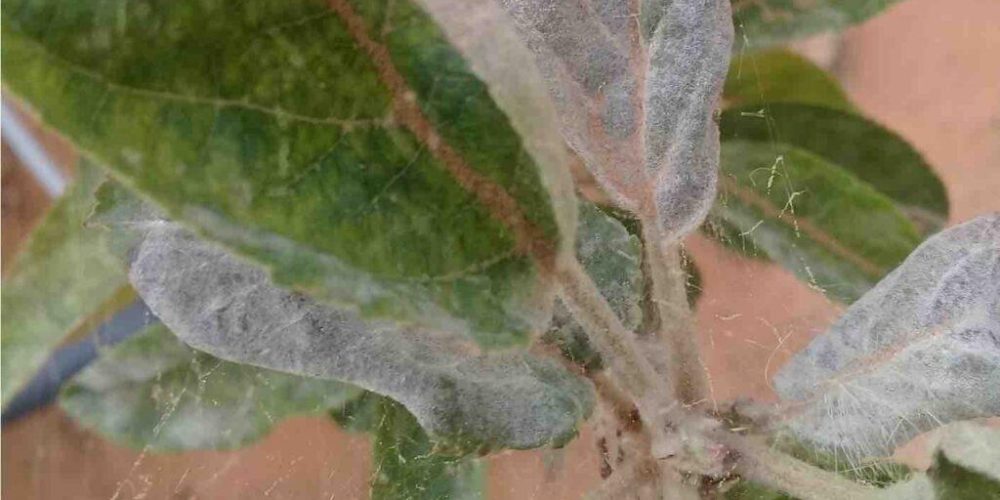Table of contents of the article
TogglePowdery mildew is a fungal disease that affects the leaves and branches of peaches, leading to poor plant growth and deformed fruits. This article from the World of Plants website reviews the symptoms of powdery mildew on peaches and methods of prevention and control.
Symptoms of powdery mildew on peaches
- Name of the disease: Powdery mildew on peaches
- Scientific name: Podosphaera leucotricha
- Disease family: This disease is one of the important diseases that affect peaches in Jordan and the Arab region.
Symptoms appear on the new tender leaves at the top of the branches, as well as on the branches, buds, fruits, and on the terminal tender leaves. Moss-appearing spots appear that are widespread on the lower surface of the leaf and may cover its entire surface. Some spots may be observed on the upper surface (as in the picture), and this is followed by yellowing of the leaves. Its shape is irregular, so it appears as if it is distorted, then it quickly withers and falls, while pale spots appear on the fruits, raised above the surface (as shown in the picture), and their color later becomes dark. The fruiting layer turns into a skin layer that withers and becomes unfit for consumption, and the same symptoms appear on the branches and buds, the most important of which is the appearance of floury matter and dryness of the branches.
Causes of powdery mildew on peaches
The disease is caused by the fungus Sphaerotheca pannosa var persica and is very similar to powdery mildew in roses.
Suitable conditions for the spread of powdery mildew on peaches
High air humidity accompanied by moderate temperatures suits the development of the disease. The relative humidity from 97 to 99% helps in the germination of fungal spores at temperatures from 17 to 24 C. Such conditions are available in the spring, especially on days when there is a lot of dew.
Development cycle of powdery mildew on peaches
The fungus spends the winter period inside dormant buds in the form of latent fungal hyphae, and when they open at the beginning of the spring, these hyphae are active to infect new growth, from which conidial spores spread. The infection is repeated during the growing season, and the white floury phase that appears on the leaves is called Oidium. The fungus forms dense, branching hyphae that grow. Among them are conidia, which carry barrel-shaped conidia in the form of chains. The conidia are spread during the season by wind and cause repeated secondary infections. Near the end of the season, the fungus produces fruiting bodies that are spherical in shape and dark in colour. Each asciate fruit contains one asciate sac with eight asciate spores inside it.
Losses of the spread of powdery mildew on peaches
It causes a significant decrease in yield, gives fruits that are unfit for consumption, and powdery mildew causes significant loss due to the removal of nutrients, decreased photosynthesis, increased respiration and transpiration, and poor growth.
Strategy for controlling powdery mildew on peaches
It is easier to defeat insects during the early stages and is more cost effective. The field should also be monitored routinely and looked for the presence of the above signs.
Sterilization: You must keep the surroundings near the crops clean by getting rid of weeds, plant dirt, damaged parts, and unwanted plants to grow. This is also the case with the surroundings of plants that are not plowed and unprotected.
Preventive measures to prevent the occurrence of powdery mildew on peaches
Effective control requires precise spraying of the entire area with large amounts of high-pressure water. A common strategy is to perform scheduled static or dynamic spraying operations.
Sulfur can cause injury to plant leaves and fruits when applied at temperatures above 32°C. Sulfur should not be applied within two weeks of applying the oil.
Avoid using products with a similar active ingredient in successive treatments. This would generate resistance to the specific ingredient used.
Recommendations for organic and chemical control of powdery mildew on peaches
Spraying trees with a fungicide such as wettable sulfur 3 times:
The first: after the end of flowering, and two weeks between the spraying and the second, and the spraying is stopped at least a month before the date of harvesting the fruits.
In conclusion, we would like to note that we, at the world of plants website, offer you all the necessary services in the world of plants, we provide all farmers and those interested in plants with three main services::-
- Artificial intelligence consulting service to help you identify diseases that affect plants and how to deal with them.
- Blog about plants, plant diseases and care of various crops ... You are currently browsing one of her articles right now.
- An application that provides agricultural consultations to clients, as well as a service for imaging diseases and knowing their treatment for free – Click to download the Android version from Google Play Store، Click to download the IOS version from the Apple App Store.
References:
Garden and home pests - University of Jordan
Powdery mildew in apples and pears - agrio




